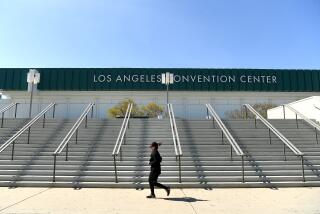Oceanside Pier to Be Restored to Former Glory
- Share via
OCEANSIDE — Characterizing their action as a bold step toward a better and more tourist-attractive Oceanside, council members on Wednesday pledged to spend almost $1.8 million to rebuild the city’s battered and historic wooden pier.
With a unanimous vote that sparked thunderous applause from a decidedly pro-pier audience, the council approved plans to demolish the aging, storm-damaged structure and reconstruct it to its original length of 1,600 feet.
To finance the project, the city will tap its general fund reserve to supplement the more than $1.7 million already accumulated for the reconstruction from the Federal Emergency Management Agency (FEMA) and several state sources. Cost of rebuilding the pier will total $3.5 million.
Despite the high price tag, Oceanside leaders wasted little time approving their share of funding for the pier, which was the longest structure of its type on the West Coast when it was built in 1947. Their haste was due in part to warnings that FEMA officials intended to withdraw their $793,000 grant if the city did not act soon.
But nostalgia may have had something to do with it as well.
“I came here 30 years ago and, at that time, the best thing you heard about Oceanside was its pier,” Councilman Sam Williamson said. “Unfortunately, that’s changed. So I think our action is one of the best and most important steps we could take for our city.”
Councilman Walter Gilbert, who has lobbied long and hard for the project, agreed. But warning those assembled for the vote that the council is “going out on a limb to pay for this thing,” Gilbert suggested--half seriously--that the community might “throw a garage sale or something” to help with the funding.
Residents and local developers who turned out for the meeting were delighted. Some described the pier as the city’s most valuable but neglected recreational asset, while others predicted that the once-popular fixture would become the focal point for Oceanside’s mounting tourism efforts.
Still others echoed the dreams of the city’s redevelopment officials, who hope the new pier will eventually host restaurants and other commercial activity and become the centerpiece of the city’s changing waterfront.
“The redevelopment area is just beginning to show the first real signs of breakthrough,” said resident Werner von Gundell. “We’re on a roll, we’re on the right path. Please, let us rebuild the pier for all of us to enjoy and help this trend continue.”
The council’s action comes seven years after record high tides and storm-driven waves swept a 560-foot chunk of the pier--including a bait shop and restaurant--out to sea. During the winter of 1982-83, the ocean struck again, and tides eventually whittled the pier down to about half its original length.
Although city officials received disaster assistance to help rebuild the lost portion years ago, studies showed that the entire pier needed to be replaced. But Oceanside had trouble coming up with its share of the reconstruction costs.
Under the funding package approved Wednesday, the city will allocate $1.77 million from the general fund and ask the state Coastal Conservancy for a loan for the same amount to replenish city coffers. Developers’ fees now earmarked for park construction and maintenance will be used to pay back the loan, probably over 10 to 15 years.
Should the loan be refused, the developers’ fees would be used to directly reimburse the general fund over a three-year period, officials said.
The council also agreed to use $675,000 in community development block grant funds to remodel and refurbish the pier’s concrete base, which anchors the structure at the shore. Officials intend to convert the base into a lifeguard headquarters.
Some residents questioned the life span of wooden piers, which are susceptible to dry rot and are generally considered less durable than concrete ones.
But Ron Noble, a coastal engineer who acted as a consultant for the city on the project, said that new “state-of-the-art” pier protection technology has significantly increased the structures’ life span.
Noble said that the pier’s timber pilings are treated with an insulating substance and are partially wrapped with a protective polyurethane material, which make pilings sound for as long as 40 years.
More to Read
Sign up for Essential California
The most important California stories and recommendations in your inbox every morning.
You may occasionally receive promotional content from the Los Angeles Times.













